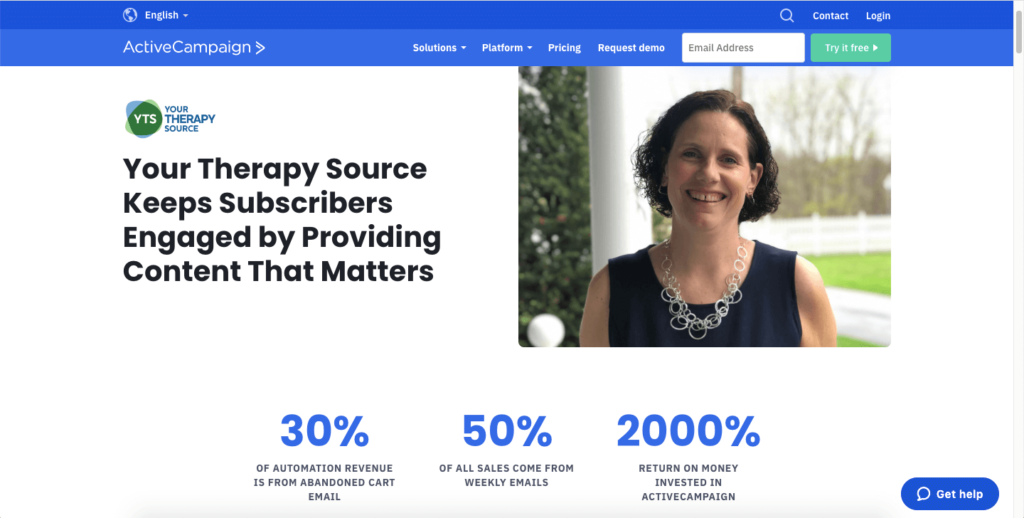As you already know, moving leads through the sales pipeline is no easy feat. In the world of digital marketing, it takes an average of 18-21 touchpoints to convert a lead. If you want any chance of pushing prospects down the funnel, you have to directly communicate the value of your product or service and one of the best ways to do this is with case studies.
Putting together a compelling social media marketing case study is one of the most powerful strategies for attracting future customers or digital agency clients. But it’s not easy. In this article, we’ll go over the ingredients of a winning case study and how to deliver said case study in the most effective way. We’ll also include a template that you can go by.
Let’s dive right in.
The importance of social media case studies
There’s a lot of content out there. Your potential customers are constantly bombarded with whitepapers, e-books, 10-step guides, newsletters and unpalatable sales hype. To get the attention of prospects today you have to demonstrate your product or service’s value, not just talk about it.
B2B buyers today don’t have time to interpret marketing messages that aren’t concise and relevant. That means that instead of aimlessly beating around the bush about how great your company is and how terrific your products are, you have to share the real-life experiences customers are having with you and your products.

Traditional marketing tactics don’t work anymore. We already know that. People nowadays drive their own buying decisions through online research and the importance of social proof cannot be understated.
About 57% of the customers will only use or buy a business service if it has at least 4 or five-star ratings. It should be noted however that reviews aren’t enough. In fact, 88% of consumers view ratings and reviews as a personal suggestion, not definitive proof of a product’s efficacy.
Reviews are all well and good but if you’re marketing B2B software or agency services, creating in-depth, data-driven case studies is the way to go. Case studies are extremely effective in the consideration stage of the buyer’s journey when they are actively comparing solutions and providers to solve a problem they’re experiencing.
As we already mentioned, your prospects are actively researching your products and there’s a 100% chance that they will stumble upon content from your competitors. Having relevant resources like case studies can cement your brand as an authority figure.
Now that you know why case studies are important it’s time to tackle the creation process.
The ingredients for a perfect case study
1. Detailed and full of data
Have you ever read a case study where a business states they “doubled traffic” for the customer in their case study, and wondered if that meant they went from 50 to 100 visits or 5,000 to 10,000 visits?
The point of a case study is to highlight the exact ways your product or service has helped a customer. The most compelling case studies hit prospects in the face with how amazing your customers’ results were, meaning you need to include numbers. Lots of them. Here’s an example:
Instead of saying “How client X got more sales thanks to us”, use “How client X increased their sales by X% in X days thanks to us”
This step may sound like a no-brainer but it’s absolutely essential to use relevant data when crafting your social media case study, especially if you run a digital agency. Include statistics like a decrease in ad spend, an improvement in engagement or increase in organic followers.
It’s important to remember that not everyone is as familiar with analytics and KPIs as you are, so break down the complicated sections into digestible bits that anyone can understand. Provide context as you go along so the data flows with the overall narrative of the case study.
Include some eye-catching visuals like picture proof or real-time dashboards so the reader can envision the positive potential of your product or service.
2. A complete, compelling story
Storytelling is a powerful marketing strategy that has stood the test of time. A great social media case study uses narrative techniques to put readers in the subject’s shoes.
When crafting your subject’s persona, be sure to include:
- Who is the sample customer, what do they do and why do they do it?
- What were the customer’s goals?
- What were the customer’s needs?
- How did you satisfy those needs and help the customer meet their goals?
As a rule of thumb, structure your case study by splitting up the main takeaways into three easy snippets: The challenge, the impact you had, and the outcome. This way you make sure that your case study isn’t all over the place and concludes with the reader being wowed.
Furthermore, you want to carry the story through and show how your business helps your customers long-term. You want your product or service to become a cornerstone of your customers’ workflow, something they simply can’t live without. When you conclude the “outcome” section of your case study, include ways customers can use your business further down the line.
When it comes to creating a compelling story, throwing in some emotional benefits alongside the hard numbers is absolutely necessary. Did your solution improve workplace morale, free up time or overall take a load off of your subject’s shoulders? Ask for a quote from the case study subject to make things more personal and relatable.
To really drive the narrative home, use quotes from your team as well. Any potential prospects will love discovering how your team overcame certain hurdles and delivered the end result. Interview your graphic designer or content manager and get them to break down the project into steps. This will help prospects further familiarize themselves with your organization and how your team thinks and operates, a connection that can help keep you top-of-mind when leads are ready to convert.
3. Compelling visuals
Using visuals and images to enrich the case study experience is a key element of a comprehensive marketing case study. But cramming in screenshots and haphazard designs is sure to have an adverse effect to what you were hoping for.
You want your case study to be a joy to read and as such it’s important to keep a few key rules in mind:
– Write a catchy headline that gives a clear idea of what the case study is about
- Leave plenty of negative space when arranging your visual elements. You don’t want a busy mess of visuals that’s hard on the eyes
- Ensure that your visual elements compliment the data and written content of your case study.
- Keep your target audience in mind. What kind of creatives would they be drawn to? What fonts, visual cues and tones would keep them hooked? It goes without saying to add your company’s unique branding as well.
- The information you present should flow like a story. The graphic elements, along with the text should guide the reader’s eye through the study from beginning to end.
To spice things up, consider adding multimedia elements such as videos, PDFs, and images to make the case study more engaging.
When getting together the creative assets for your case study, be sure to include headshots of the actual customer, dashboards of results (graphs are great for visual storytelling) and screenshots of any social media posts that were created during the campaign (if relevant).
You can use tools like Kontentino’s social media analytics tool to implement custom metrics and create stunning reports.
Relatable to your target audience
If you’re at the point where you’re sharing success stories, chances are that you know who your ideal customer is. When crafting a case study, you want to write to the audience that you’re trying to attract. The readers of your study will most likely be very similar to the customers you’re writing about.
People who will read your case study most likely have a decent understanding of what your business is and what you can offer. They’re already somewhere in the middle of your funnel and as such it’s time to take advantage of personalization. Now you may need to create multiple case studies tailored toward different audiences, but it’s sure to pay off in the long run.
Reflect on the project you’re highlighting in the case study and think about who the customer was. What industry were they in? What kind of client were they? Were they visually-oriented? Did they appreciate heavy-handed analytical reports, a good story or a combination of the two?
These insights can help you nail down the written tone and show potential clients that you understand their specific needs, are comfortable in their niche and can apply strategies in accordance to their use-case.
Different ways to deliver a social media marketing case study
If you just created an amazing case study that’s sure to knock readers’ socks off, you want people to find it. This means populating every channel at your disposal with your content so your potential customers can’t miss it.
- YouTube
Youtube is the second-largest search engine in the world and the platform’s algorithm holds the potential to show your video to a whole new audience. While YouTube’s algorithm is often iffy, writing a catchy title, detailed description and creating an effective thumbnail are good ways to keep your video in the algorithm’s favor.
In addition, you’ll want to link your full case study in the comments and get viewers to land on your website.
- Social media
If you’re creating a social media case study, using social media to share said case study should be a no-brainer.
Break down the content of your case study into bite-sized chunks for Instagram or Facebook, post analytics dashboards from the study on Twitter and link the study in a LinkedIn post to spice up your profile. The shareable nature of social media may lead to your case study going further than just your own site.
- Embedded in other types of content
Case studies can also be embedded in other types of content like blog posts, newsletters, guides or ebooks. Go through your current pieces of relevant content and link to your case study to provide extra value.
3 winning social media marketing case study examples
Now that we’ve gone over the components of a winning social media case study, let’s check out some real world examples.
1. “How ERA Belgium Provides Great Content for Franchise Businesses with Kontentino,” by Kontentino

A thing to note regarding this case study is how Kontentino not only highlighted the impressive data but also how the product helped solve a core pain point for ERA Belgium’s franchises.
Highlighted in the middle of the case study is a bold quote from the client that helps solidify Kontentino’s KontentBase product as a must-have tool for franchises. When creating your own case study, consider your product and who’s needs it addresses. Align your customer quotes and data and results reports to match exactly what your target audience is looking for.
The Konetino case study also includes a CTA at the end so any potential prospects could directly contact the support team.
2. “How an SEO Agency Helped an Artisan Bakery Increase Organic Traffic by 214%,” is a very well written case study by Semrush
This comprehensive case study by Semrush is a perfect example of pinpoint narrative structure and proper formatting. The study flows like a well-written story and guides the reader through the subjects, conflicts and resolutions without a hitch. The tasteful addition of dashboards and bullet points ties the case study up perfectly.
3. “How Good Dye Young Increased Their Monthly E-commerce Revenue by 305%,” an impressive storytelling case study by Mailchimp
This case study by MailChimp is full of personality and storytelling. While MailChimp did include impressive numbers, the centerpiece of this case study is the people. The subjects in the case study are referenced casually by their first names, their journey is explored in-depth and there’s no shortage of quotes from them. The imaging MailChimp uses only emphasizes the human side of the relationship between them and the customer.
Keeping you on track with your social media case study
So now you’ve got a solid idea of what a comprehensive case study should include and you’ve seen the techniques we’ve covered in action. Now it’s time to go over a full template to ensure you stay on track when creating your awesome social media case study.
Social media marketing case study template
Outline: Case Study Title
Customer: Customer’s full name
Company: Company’s name
Industry: The industry the customer operates in (if applicable)
Video: Link to a video version (if applicable)
Author: Author’s name
Case study title
Summary
A short introduction of the customer.
Be sure to highlight:
- The customer’s name and a little bit about them.
- Why you and your customer were a perfect fit
- The key successes your customer had after working with you
Introduce your customer
In this section, provide a more in-depth overview of your customer. If it’s an individual, explain the person’s background in the context of your product/service. If it’s a business, talk about the company’s background, industry and any recent successes or milestones they have had.
Describe the problem
Explain the challenge or opportunity your customer faced before they did business with you. This could be either a reactive reason (i.e. the customer had an issue that needed to be addressed) or a proactive reason (i.e. there was an untapped potential that was unleashed by working with your business).
Why (Customer Name) Chose (Your Company)
In this section, speak about the decision process of your customer. Speak about how they discovered you, your possible competition and what made them ultimately decide to do business with you.
How (Your Company) Responded
Here, explain what happened once your business started working with your customer. What was addressed first, and why? How did your customer feel about working with you in the early days?
The Results
In closing, speak to the results your customer saw after working with you. This section can be supported by statements, quotes, visuals, graphs, and metrics. Whatever you decide to include, be sure it illustrates how much of an impact your company made on your customer.
Call-to-Action
Use this section to move your readers down the funnel. Add a CTA that encourages readers to either join your newsletter or get in touch with your sales team.








